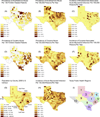Acute myocardial infarction in young adults who abuse amphetamines
- PMID: 18353567
- PMCID: PMC2533107
- DOI: 10.1016/j.drugalcdep.2008.01.027
Acute myocardial infarction in young adults who abuse amphetamines
Abstract
Background: Case reports suggest a link between methamphetamine abuse and acute myocardial infarction (AMI), but no epidemiologic studies have examined this link. Our objective was to test the hypothesis that young adults who abuse amphetamines are at higher risk for AMI.
Methods: In this study of 3,148,165 discharges from Texas hospitals in a quality indicators database during 2000-2003, among persons aged 18-44 years we identified 11,011 AMIs, defined according to the Agency for Healthcare Research and Quality's AMI mortality inpatient quality indicator.
Results: In a multiple logistic regression analysis - while controlling for cocaine abuse, alcohol abuse, tobacco use, hypertension, diabetes mellitus, lipid disorders, obesity, congenital defects, and coagulation defects - amphetamine abuse was significantly associated with AMI (adjusted odds ratio=1.61; 95% CI=1.24-2.04, p=0.0004). The rate of AMIs among amphetamine abusers increased significantly from 2000 to 2003. The population attributable risk suggests that amphetamine abuse is responsible for 0.2% of AMIs in the state of Texas. The geographical distribution of amphetamine abuse varied by region, with the prevalence being highest in the North Texas and Panhandle regions of Texas.
Conclusions: This modest, though statistically robust, association suggests that amphetamine abuse may play a role in AMI.
Figures


Similar articles
-
Stroke in young adults who abuse amphetamines or cocaine: a population-based study of hospitalized patients.Arch Gen Psychiatry. 2007 Apr;64(4):495-502. doi: 10.1001/archpsyc.64.4.495. Arch Gen Psychiatry. 2007. PMID: 17404126
-
Comparative hazards of acute myocardial infarction among hospitalized patients with methamphetamine- or cocaine-use disorders: A retrospective cohort study.Drug Alcohol Depend. 2018 Jul 1;188:259-265. doi: 10.1016/j.drugalcdep.2018.03.030. Epub 2018 Apr 26. Drug Alcohol Depend. 2018. PMID: 29793190
-
Aortic dissection in young adults who abuse amphetamines.Am Heart J. 2010 Aug;160(2):315-21. doi: 10.1016/j.ahj.2010.05.021. Am Heart J. 2010. PMID: 20691838 Free PMC article.
-
Clinical Outcomes of Acute Myocardial Infarction Hospitalizations With Systemic Lupus Erythematosus: An Analysis of Nationwide Readmissions Database.Curr Probl Cardiol. 2022 Nov;47(11):101086. doi: 10.1016/j.cpcardiol.2021.101086. Epub 2021 Dec 20. Curr Probl Cardiol. 2022. PMID: 34936910 Review.
-
Prevalence of myocardial infarction among patients with chest pain and cocaine use: A systematic review and meta-analysis.Am J Emerg Med. 2021 Dec;50:428-436. doi: 10.1016/j.ajem.2021.08.024. Epub 2021 Aug 19. Am J Emerg Med. 2021. PMID: 34482129
Cited by
-
Methamphetamine induces cardiomyopathy by Sigmar1 inhibition-dependent impairment of mitochondrial dynamics and function.Commun Biol. 2020 Nov 17;3(1):682. doi: 10.1038/s42003-020-01408-z. Commun Biol. 2020. PMID: 33203971 Free PMC article.
-
Fatal intoxications and inherited cardiac disorders in the young: where to draw the line?Int J Legal Med. 2025 May;139(3):1081-1091. doi: 10.1007/s00414-025-03439-9. Epub 2025 Feb 12. Int J Legal Med. 2025. PMID: 39937272 Free PMC article. Review.
-
The metabolic and cardiovascular effects of amphetamine are partially mediated by the central melanocortin system.Cell Rep Med. 2025 Feb 18;6(2):101936. doi: 10.1016/j.xcrm.2025.101936. Epub 2025 Feb 5. Cell Rep Med. 2025. PMID: 39914386 Free PMC article.
-
Quinolyl analogues of norlobelane: novel potent inhibitors of [(3)H]dihydrotetrabenazine binding and [(3)H]dopamine uptake at the vesicular monoamine transporter-2.Bioorg Med Chem Lett. 2015 Jul 1;25(13):2613-6. doi: 10.1016/j.bmcl.2015.04.105. Epub 2015 May 9. Bioorg Med Chem Lett. 2015. PMID: 25991431 Free PMC article.
-
Risk factors for chronic non-communicable diseases at gilgel gibe field research center, southwest ethiopia: population based study.Ethiop J Health Sci. 2012 Aug;22(S):19-28. Ethiop J Health Sci. 2012. PMID: 23319837 Free PMC article.
References
-
- American Hospital Association. AHA guide to the health care field American Hospital Association. Chicago: 2004.
-
- Bashour TT. Acute myocardial infarction resulting from amphetamine abuse: a spasm-thrombus interplay? Am Heart J. 1994;128:1237–1239. - PubMed
-
- Basso C, Maron BJ, Corrado D, Thiene G. Clinical profile of congenital coronary artery anomalies with origin from the wrong aortic sinus leading to sudden death in young competitive athletes. J Am Coll Cardiol. 2000;35:1493–1501. - PubMed
-
- Bateman BT, Schumacher HC, Bushnell CD, Pile-Spellman J, Simpson LL, Sacco RL, Berman MF. Intracerebral hemorrhage in pregnancy: frequency, risk factors, and outcome. Neurology. 2006;67:424–429. - PubMed
-
- Bruzzi P, Green SB, Byar DP, Brinton LA, Schairer C. Estimating the population attributable risk for multiple risk factors using case-control data. Am J Epidemiol. 1985;122:904–914. - PubMed
Publication types
MeSH terms
Grants and funding
LinkOut - more resources
Full Text Sources
Medical

